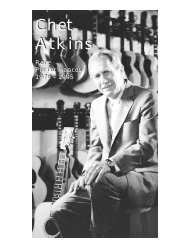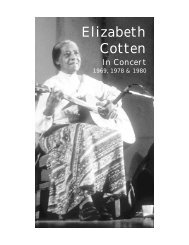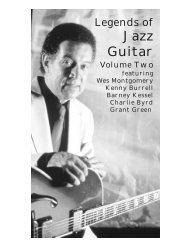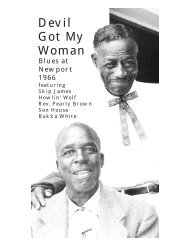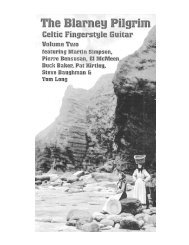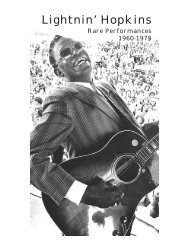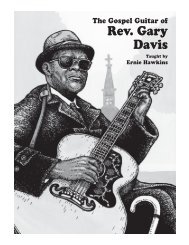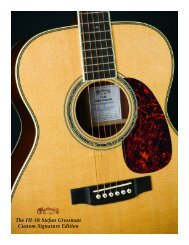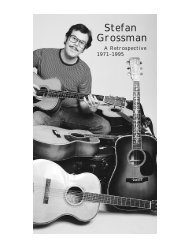Stefan Grossman Stefan Grossman - Stefan Grossman's Guitar ...
Stefan Grossman Stefan Grossman - Stefan Grossman's Guitar ...
Stefan Grossman Stefan Grossman - Stefan Grossman's Guitar ...
You also want an ePaper? Increase the reach of your titles
YUMPU automatically turns print PDFs into web optimized ePapers that Google loves.
A<br />
s <strong>Stefan</strong> <strong>Grossman</strong> sits at his computer proudly<br />
sharing digitally remastered tracks of Rev. Gary<br />
Davis playing, singing and preaching from 1962,<br />
a sense of nostalgia emanates from his face.<br />
<strong>Stefan</strong> first recorded Rev. Davis almost 50 years ago<br />
with an old reel-to-reel tape deck beside the stage at Gerdes Folk<br />
City in Greenwich Village; in 2008, he put out a remastered three-CD<br />
set of those concerts. And he recently brought a second volume (At<br />
Home and Church) of the legendary black blues guitarist into the digital<br />
age. This is perhaps <strong>Stefan</strong>’s most important project: preserving the<br />
music of Rev. Davis, his early mentor, for the masses. And, yes, there are<br />
masses of would-be guitarists and southern blues fans – one need look no<br />
further than the number of hits on <strong>Grossman</strong>’s website or the number of<br />
subscribers to his YouTube channel to see that.<br />
<strong>Stefan</strong> <strong>Grossman</strong> is a musical Renaissance man. He’s not the most famous<br />
musician, in the traditional sense of that phrase, but he’s one of the finest<br />
guitar players in the world and has been for four decades: 20 years in<br />
Europe during which he became a fixture on the British music scene,<br />
then back in America for the last 22 years, where he has become one of<br />
the primary resources for the dissemination of underappreciated guitar<br />
styles. <strong>Grossman</strong> may well be the world’s foremost authority on American<br />
southern blues music and how to play it. Such a title covers a lot of<br />
territory. Today, he is a musician, a performer, a recording artist, a<br />
visual artist, a writer, a teacher, a producer and a businessman.<br />
<strong>Stefan</strong> <strong>Grossman</strong> was born in 1945 and grew up in Brooklyn,<br />
N.Y. He didn’t take to the guitar right away, but around age<br />
15, his obsession started. “It was a combination of puberty, shyness,<br />
an attraction to the music and the realization that if you<br />
played music and had a party it was an easier way to meet girls,”<br />
he offered with a twinkle.<br />
During our conversation, <strong>Stefan</strong> recalled some of his most<br />
memorable onstage appearances: at Hyde Park in England with<br />
Pink Floyd; at Carnegie Hall with the Even Dozen Jug Band;<br />
in Bologna, Italy, with Mike Bloomfield; and at the Great<br />
American Music Hall in San Francisco with John<br />
Renbourn. But it all began in the early 1960s, on Sunday<br />
afternoons in Washington Square Park in Greenwich<br />
Village, where <strong>Grossman</strong> was one of countless<br />
musicians vying for the eyes and ears of spectators, passersby<br />
and one another. Out of that experience grew the<br />
Even Dozen Jug Band, an eclectic group of iconoclasts<br />
that “ended up playing concerts and making a record. We<br />
played Carnegie Hall twice, Johnny Carson, the Hootenanny<br />
show ... and then we broke up because we were all students,”<br />
<strong>Grossman</strong> recalled. “It lasted just about a year.” The loosely<br />
knit ensemble included John Sebastian, Maria D’Amato<br />
(Muldaur), Joshua Rifkin, David Grisman and Steve Katz.<br />
After the jug band, <strong>Grossman</strong> played briefly with two electric<br />
groups – The Fugs and Chicago Loop – and signed in 1966 to play<br />
in a band with Janis Joplin and Taj Mahal. But when both backed<br />
out, <strong>Stefan</strong> headed for Europe, where there was no shortage of places<br />
to stay and jam for a virtuoso blues guitarist. One of those places was<br />
Eric Clapton’s house. “I was pretty close with all the guys in the Cream,”<br />
he said, referring to Clapton, Ginger Baker and Jack Bruce. For <strong>Grossman</strong>,<br />
it was the start of a unique career that, then and now, defies categorization.<br />
Vol. 53 #4 • Sing Out! 53



